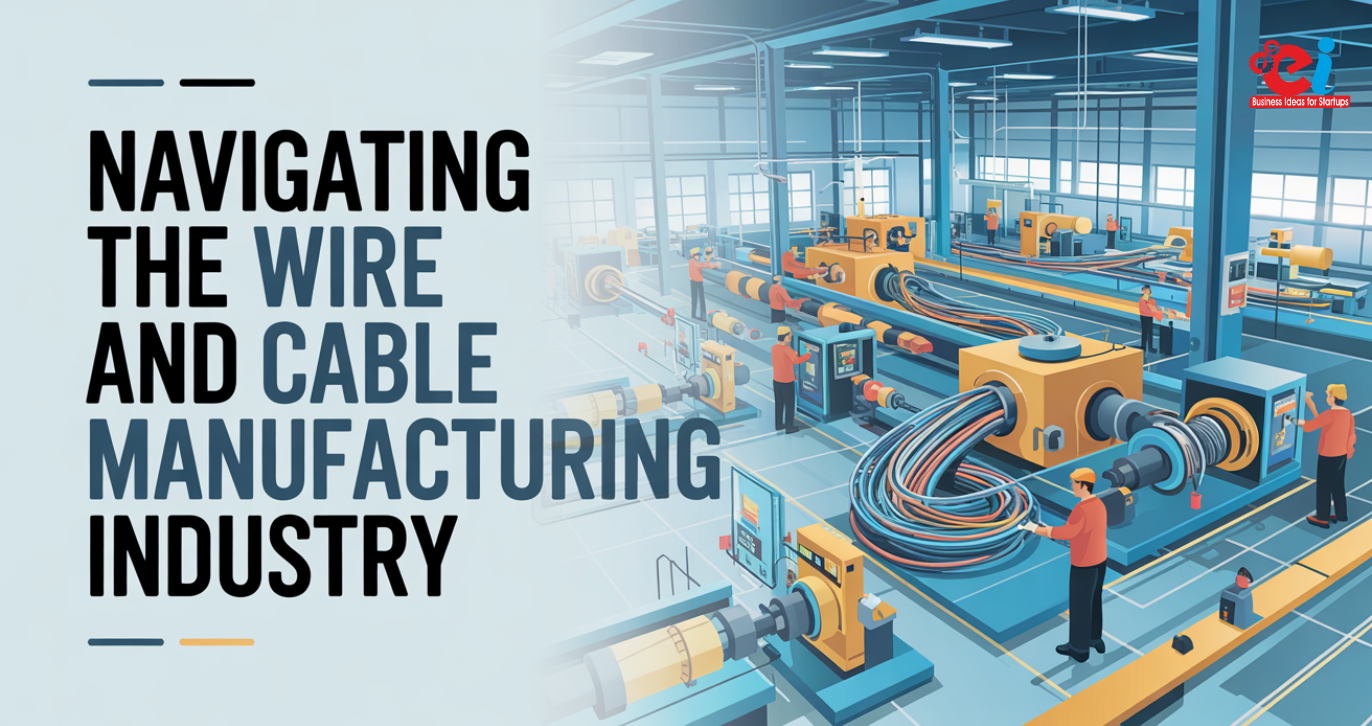The wire and cable manufacturing industry is very much a part of modern infrastructure and has a widespread reliance in varied fields such as telecommunications, power distribution, automotive, and construction. The wire and cable industry is an important part of modern infrastructure, playing a critical role in telecommunications, power distribution, automotive, and construction. To understand the workings of this industry, you should pay attention to its operations, trends, and other relevant elements.
Important Elements of Wire and Cable Manufacturing
Conductor:
- The core material of any wire or cable, such as copper and aluminum, is a good conductor of electricity.
- Stranded conductors provide flexibility, while solid conductors are less flexible.
- Copper should be preferred when conductivity is highly important, and aluminum should be opted for when weight and cost are concerns.
Insulation:
- An insulation material that surrounds a conductor to protect it from any leakage of current.
- The following are among the usual suspects for cable insulation: PVC (Polyvinyl Chloride), XLPE (Cross-linked Polyethylene), and Teflon.
- Use and abuse conditions, besides expected environmental conditions that the cable will be subjected to, may influence other calibers of the same insolation materials.
Shielding
- Method of minimizing Electro-Magnetic Interference (EMI) and Radio Frequency Interference (RFI).
- An example of shielding is metallic braids and/or foil wraps that can add to the communication and power cables.
- It is especially significant in industrial environments where EMI will affect performance.
Jacket
It is the outermost protective covering for cables from mechanical damage, moisture, and environmental hazards. Different jackets can be rubber or plastic, or thermoplastic material. Quite evidently, a good jacket will, therefore, prolong the life of a cable while also being resistant to numerous chemicals and abrasions.
Read our blogs: Profitable Hot Dip Galvanizing Business: A Lucrative Startup Opportunity
Wire and Cable Manufacturing Process
Drawing
- Drawing is the first stage in the process of obtaining wire, where raw metal is brought through a die to permit its cross-section to be reduced into thin wire.
- It determines the wire’s strength, flexibility, and conductivity.
Annealing
- Heat is applied to soften the drawn wire to improve its flexibility and conductivity.
- This is a process that makes wires less so that they may easily break with brittle faults.
Stranding
- A stranded conductor essentially consists of several thin wires twisted together.
- Stranded wires are used where flexible wires are needed, for example, in automotive and robotic applications.
Extrusion
- Extruded insulation makes the wire safe.
Cabling
- Cables consist of several insulated wires tied together.
- The arrangement of insulated wires will determine the efficiency and life of the cable.
Shielding and Armoring
- It will give an extra layer of protection for the cable from damage and change by the exterior.
- Shielding will prevent loss of a signal in communication cables, and armoring will protect the cables in any hostile environment.
Testing and Quality Control
- The finished cable must undergo rigorous tests for strength and resistivity, as well as for insulation quality.
- Standard quality control is very important in safety and performance.
Types of Wires and Cables
Power Wire
- In power transmission and distribution.
- High voltage, medium voltage, and low voltage.
- These cables supply reliable power to houses, industries, and commercial areas.
Communication Cables
- Use for data transmission in telecommunications and networking.
- Fiber optics, coaxial, and Ethernet cables are included in this.
- There has been much dynamism in the innovations in cable technology. High speed in data transfer is what demanded their existence.
Automotive Cables
- Able to withstand heat, vibration, and chemicals used in the modern-day vehicle.
- Used in EVs, traditional vehicles, and hybrid systems.
Industrial Cables
Used in factories, machinery, and robotics to control operations.
Acts under a lot of wear and tear.
Specialty Cables
- Aircraft, defence, and medical applications.
- Such cable will, in many instances, require high-tech materials and coatings.
Market Trends and Future of the Wire and Cable Industry
Increased Demand for Renewable Energy Cables
- Governments worldwide are investing in green energy projects; this, in turn, creates demand for efficient transmission cables.
Expanding Fiber Optics
- Increasing Internet penetration has generated demand for fast fiber optic cables.
- 5G technology assures further investments in building fiber-backbone infrastructure.
Smart & IoT-enabled Cables
- The Internet of Things (IoT) is creating demand for intelligent cables that can carry out real-time monitoring.
- Smart cables facilitate energy usage monitoring and enhance industry efficiency.
Sustainable and Recyclable Material
- The material is being produced to protect the environment.
- Manufacturers are looking into biodegradable insulation and a less impactful manufacturing process.
Electrification of Transportation
- With the rise of electric vehicles (EVs), the demand for high-voltage cables is continually rising.
- EV charging infrastructure also requires specialized power cables.
Challenges in the Wire and Cable Industry
Following are some of the major challenges in the Wire and Cable Industry:
Fluctuating Raw Material Costs
- Prices of Copper, aluminum, and plastics affect the manufacturing costs.
- Market fluctuations affect production budgets and pricing programs.
Regulatory Compliance
- Manufacturers must comply with the strict measures relating to safety and quality.
- This entails harsh fines and potential product recall in case of violation.
Counterfeited Product
- The counterfeit production of goods is a major problem, and it seems to have impacted the manufacturing sector. These counterfeit goods have a lower standard of quality than their legitimate counterparts.
Supply Chain Disruption
- Any delays in raw material availability or logistics hinder production schedules.
- Global supply chain issues exhibit the need for the localization of manufacturing.
Technological Adoption
- Those who keep abreast of emerging techniques truly commit to research and development on a sustained basis.
- A company that doesn’t innovate is going to start losing its power of competition.
Closing Thoughts
The industry that manufactures wires and cables is dynamic and vital for many applications worldwide. Knowing its components, processes, and trends will assist industries in making informed decisions. Therefore, in this present scenario where technology and sustainability are the main attributes introducing the near future, remaining attuned to the voice of the industry will act as an edge for survival. Investment in good material, innovation, and regulatory compliance will fast-track manufacturers in settling a place in this burgeoning industry.










